Analysis of Influencing Factors on Spatial Distribution Characteristics of Traditional Villages in the Liaoxi Corridor
Abstract
1. Introduction
1.1. Spatial Pattern Types and Research Progress
1.2. Drivers and Comprehensive Assessment
1.3. Research Area and Shortcomings
1.4. Research Objectives and Innovations
- Do traditional villages in the Liaoxi Corridor exhibit significant spatial aggregation or linear distribution characteristics?
- How do factors such as natural geography, human society, and cultural resources jointly drive the spatial distribution of villages?
- How do regional characteristics affect the above driving mechanisms, and what are the similarities and differences with studies in the southeast?
- Filling the regional research gap: the first systematic revelation of the spatial pattern of traditional villages in the northern cultural corridor.
- Methodological refinement: critical comparison in MCDA assignment and parameter selection, and combination of spatial autocorrelation indicators.
- Practical significance: to provide the classification, conservation, and rural revitalization of the Liaoxi Corridor and provide quantitative decision support.
2. Materials and Methods
2.1. Overview of the Study Area
2.2. Data Sources and Research Methods
2.3. Research Methods
2.3.1. Nearest-Neighbor Index (NNI)
2.3.2. Standard Deviation Ellipses
- CenterX and CenterY represent the geographic centroid coordinates (longitude and latitude or projected coordinates) of the distribution.
- XStdDist and YStdDist measure the spatial dispersion along the major (long) and minor (short) axes of the ellipse, respectively, where larger values indicate greater spread.
- Rotation specifies the orientation angle of the ellipse’s major axis relative to the north, indicating the predominant directional trend.
- Shape_Length and Shape_Area quantify the ellipse’s perimeter and coverage area, reflecting the spatial extent and complexity of the distribution.
2.3.3. Kernel Density Analysis
2.3.4. Geographic Detector
3. Research Results
3.1. Characteristics of Spatial Distribution of Traditional Villages in the Liaoxi Corridor
3.1.1. Types of Spatial Distribution
3.1.2. Balanced Spatial Distribution
3.1.3. Directionality of Spatial Distribution
3.1.4. Spatial Distribution Clustering Characteristics
3.2. Analysis of Influencing Factors on the Distribution of Traditional Villages in the Liaoxi Corridor
3.2.1. Topography and Geomorphology Factors
3.2.2. Climatic and Ecological Factors
3.2.3. Environmental Factors
3.2.4. Population and Economic Factors
3.2.5. Transportation and Location Factors
3.2.6. Historical and Cultural Factors
4. Discussion
4.1. Consistency and Difference Between Results and Existing Studies
4.2. Relative Importance and Mechanisms of Influencing Factors
4.3. Suggestions for Cultural Protection and Coordinated Regional Development in the Liaoxi Corridor Region
4.4. Research Limitations and Future Research Directions
4.5. Policy Relevance and Planning Implications
4.5.1. Optimize Land-Use Planning and Regional Layout Control
4.5.2. Strengthening the Priority Supply of Infrastructure and Public Services
4.5.3. Strengthening Traditional Village Protection and Adaptive Use Strategies
5. Conclusions
Author Contributions
Funding
Data Availability Statement
Conflicts of Interest
Appendix A
Appendix A.1
Appendix A.2. Explanation of Factors Affecting Traditional Village Distribution
| Factor Name | Description | Data Source/Measurement Method | Unit/Index Type |
| Night Light | Intensity of nighttime lights, reflecting regional economic activity and light pollution | Satellite remote sensing nighttime light data (e.g., VIIRS) | Light intensity index (dimensionless) |
| GDP | Gross domestic product, indicating the level of regional economic development | Local statistical yearbooks or government economic statistics | Ten thousand RMB |
| Population Density | Number of permanent residents per unit area | Census data | Persons per square kilometer |
| Distance to River | Distance to the nearest river, indicating water resource accessibility | GIS spatial analysis | Meters |
| Road Density | Total length of roads per unit area | Road network vector data | Meters per square kilometer |
| Humidity | Air humidity, indicating the moisture level of the climate | Meteorological station observations | Relative humidity (%) |
| Distance to City | Distance to the nearest city center, reflecting transportation accessibility and market influence | GIS spatial measurement | Kilometers |
| DEM | Digital Elevation Model, representing terrain relief and elevation | Remote sensing data or digital elevation data | Meters |
| Temperature | Average temperature, reflecting regional climatic characteristics | Meteorological station observations | Degrees Celsius (°C) |
| Precipitation | Annual precipitation, indicating regional water resources | Meteorological station observations | Millimeters (mm) |
| NDVI | Normalized Difference Vegetation Index, reflecting vegetation coverage | Remote sensing imagery (e.g., MODIS) | Dimensionless index, range [−1, 1] |
| Relief Slope | Terrain slope, indicating terrain ruggedness | DEM spatial analysis | Degrees (°) |
References
- Computer Network Information Center, Chinese Academy of Sciences. Geospatial Data Cloud. 2024. Available online: http://www.gscloud.cn (accessed on 25 February 2024).
- Lu, Y.; Ahmad, Y. Heritage Protection Perspective of Sustainable Development of Traditional Villages in Guangxi, China. Sustainability 2023, 15, 3387. [Google Scholar] [CrossRef]
- Wang, X.; Zhu, Q. Influencing Factors of Traditional Village Protection and Development from the Perspective of Resilience Theory. Land 2022, 11, 2314. [Google Scholar] [CrossRef]
- Zhou, M.; Chu, S.; Du, X. Safeguarding Traditional Villages in China: The Role and Challenges of Rural Heritage Preservation. Built Herit. 2019, 3, 81–93. [Google Scholar] [CrossRef]
- Ann, T.W.; Wu, Y.; Zheng, B.; Zhang, X.; Shen, L. Identifying Risk Factors of Urban–Rural Conflict in Urbanization: A Case of China. Habitat Int. 2014, 44, 177–185. [Google Scholar] [CrossRef]
- Wang, Y.C. The Models of Traditional Culture Landscape Conservation Based on Landscape Fragmentation Analysis: A Case Study of Zhibuzhen in Zhejiang Province. Geogr. Res. 2011, 30, 10–22. [Google Scholar]
- Jia, A.; Liang, X.; Wen, X.; Yun, X.; Ren, L.; Yun, Y. GIS-Based Analysis of the Spatial Distribution and Influencing Factors of Traditional Villages in Hebei Province, China. Sustainability 2023, 15, 9089. [Google Scholar] [CrossRef]
- Su, H.; Wang, Y.; Zhang, Z.; Dong, W. Characteristics and Influencing Factors of Traditional Village Distribution in China. Land 2022, 11, 1631. [Google Scholar] [CrossRef]
- Li, B.; Liu, P.; Dou, Y.; Zeng, C.; Chen, C. Transformation and Development of Human Settlement Environments in Traditional Villages in China and Its Research Progress. Geogr. Res. 2017, 36, 1886–1900. (In Chinese) [Google Scholar]
- Wang, H.; He, Y. Analysis on Tourism Evaluation and Cooperative Mechanism of Liaoxi Corridor. In Proceedings of the 2018 2nd International Conference on Education, Economics and Management Research (ICEEMR 2018), Singapore, 22–24 June 2018; Atlantis Press: Paris, France, 2018; pp. 409–412. [Google Scholar] [CrossRef]
- Fan, X.; Wang, Z.; Li, S. Value Evaluation Model (VEM) of Ancient Chinese Military Settlement Heritage: A Case Study of Liaoxi Corridor in the Ming Dynasty. Herit. Sci. 2024, 12, 97. [Google Scholar] [CrossRef]
- Tao, G.; Li, X.; Tian, S.; Li, H.; Song, Y. Influence of Human Settlements Factors on the Spatial Distribution Patterns of Traditional Villages in Liaoning Province. Humanit. Soc. Sci. Commun. 2024, 11, 1757. [Google Scholar] [CrossRef]
- Chen, Y.; Li, R. Spatial Distribution and Type Division of Traditional Villages in Zhejiang Province. Sustainability 2024, 16, 5262. [Google Scholar] [CrossRef]
- Zhang, Q.; Wang, J. Spatial Differentiation and Driving Factors of Traditional Villages in Jiangsu Province. Sustainability 2023, 15, 11448. [Google Scholar] [CrossRef]
- Xiao, W.; Huang, E.; Li, C.; Li, H. Investigating the spatial distribution and influencing factors of traditional villages in Qiandongnan based on ArcGIS and Geodetector. Sci. Rep. 2025, 15, 5786. [Google Scholar] [CrossRef] [PubMed]
- Ma, Y.; Zhang, Q.; Huang, L. Spatial distribution characteristics and influencing factors of traditional villages in Fujian Province, China. Humanit. Soc. Sci. Commun. 2023, 10, 883. [Google Scholar] [CrossRef]
- Su, X.; Zhou, H.; Guo, Y.; Zhu, Y. Multi-Dimensional Influencing Factors of Spatial Evolution of Traditional Villages in Guizhou Province of China and Their Conservation Significance. Buildings 2024, 14, 3088. [Google Scholar] [CrossRef]
- Ma, H.; Tong, Y. Spatial Differentiation of Traditional Villages Using ArcGIS and GeoDa: A Case Study of Southwest China. Ecol. Inform. 2022, 68, 101416. [Google Scholar] [CrossRef]
- Chen, W.; Yang, Z.; Yang, L.; Wu, J.; Bian, J.; Zeng, J.; Liu, Z. Identifying the Spatial Differentiation Factors of Traditional Villages in China. Herit. Sci. 2023, 11, 149. [Google Scholar] [CrossRef]
- Liaoning Provincial Bureau of Statistics. Liaoning Statistical Yearbook 2023; China Statistics Press: Beijing, China, 2023. Available online: https://tjj.ln.gov.cn/tjxx/xxcx/tjnj/otherpages/2023/zk/indexch.htm (accessed on 2 February 2024).
- Wang, Z.; E, S.; Ding, T.; Zhang, L.; Islam, M.; Ji, L. Spatial Distribution Characteristics and Influencing Mechanism of Rural Settlements in Mountainous Areas. Trans. Chin. Soc. Agric. Eng. 2022, 38, 123–132. [Google Scholar] [CrossRef]
- Chen, S.; Mehmood, M.S.; Liu, S.; Gao, Y. Spatial Pattern and Influencing Factors of Rural Settlements in Qinba Mountains, Shaanxi Province, China. Sustainability 2022, 14, 10095. [Google Scholar] [CrossRef]
- Li, Z.; Cheng, S.; Xiao, L.; Wei, Y.; Fang, T. Sustainability Benefit Evaluation and Optimization of Rural Public Spaces under Self-Organization Theory. Sustainability 2025, 17, 1019. [Google Scholar] [CrossRef]
- Wu, C.; Chen, M.; Zhou, L.; Liang, X.; Wang, W. Identifying the Spatiotemporal Patterns of Traditional Villages in China: A Multiscale Perspective. Land 2020, 9, 449. [Google Scholar] [CrossRef]
- Zhou, Y.; Huang, H.; Liu, Y. Spatial Distribution Patterns and Influencing Factors of Villages in China. Acta Geogr. Sin. 2020, 75, 2206–2223. (In Chinese) [Google Scholar] [CrossRef]
- Ma, B.; Chen, X.; Ma, K.; Pu, L. Spatial Distribution, Type Structure, and Influencing Factors of Key Rural Tourism Villages in China. Econ. Geogr. 2020, 40, 190–199. (In Chinese) [Google Scholar] [CrossRef]
- Li, J.; Wang, X.; Li, X. Analysis of Spatial Distribution Characteristics and Influencing Factors of Traditional Villages in China. Econ. Geogr. 2020, 40, 143–153. (In Chinese) [Google Scholar]
- Li, Y.; Chen, T.; Wang, J.; Wang, D. Spatiotemporal Distribution Characteristics and Formation Mechanisms of China’s Famous Historical and Cultural Villages. Geogr. Res. 2013, 32, 2072–2082. (In Chinese) [Google Scholar]
- Fang, Y.; Lu, H.; Huang, Z.; Zhu, Z. Spatiotemporal Distribution Characteristics and Influencing Factors of Traditional Villages in China. Econ. Geogr. 2023, 43, 187–196. (In Chinese) [Google Scholar] [CrossRef]
- Han, Z.; Li, B.; Zhang, K. Equalization of Basic Public Services in Urban and Rural China and Its Spatial Pattern Analysis. Geogr. Res. 2015, 34, 2035–2048. (In Chinese) [Google Scholar]
- Zhou, Y.; Cao, J.; Tian, L.; Luo, Y.; Ning, S. Evaluation of Spatial Form and Activation Strategies of Traditional Villages Using Spatial Information Technology. J. Chin. Archit. Urban. 2024, 6, 2502. [Google Scholar] [CrossRef]
- Fan, L.; Liu, Y.; Zhang, D. Spatial Pattern and Influencing Factors of Tourism Development in Traditional Villages in China. Econ. Geogr. 2023, 43, 203–214. (In Chinese) [Google Scholar] [CrossRef]
- Shi, Y. Urban–Rural Spatial Integration Planning under the Background of Territorial Spatial Planning. Front. Nat. Sci. 2025, 1, 94–98. (In Chinese) [Google Scholar]
- Li, Y.; Westlund, H.; Liu, Y. Why Some Rural Areas Decline While Some Others Not: An Overview of Rural Evolution in the World. J. Rural Stud. 2019, 68, 135–143. [Google Scholar] [CrossRef]
- Liu, Y.; Liu, J.; Zhou, Y. Spatio-Temporal Patterns of Rural Poverty in China and Targeted Poverty Alleviation Strategies. J. Rural Stud. 2017, 52, 66–75. [Google Scholar] [CrossRef]
- Zhou, M.; Wang, Y.; Li, G. From Self-Governance to Co-Governance: The Spatial Governance Logic of Traditional Villages in Suzhou from the Perspective of Institutional Change. Hum. Geogr. 2024, 39, 72–82. (In Chinese) [Google Scholar] [CrossRef]
- Jiao, S.; Zheng, Z.; Xu, F.; Li, C.; Li, H.; Ma, B. Marginalized Distribution Characteristics of Traditional Villages: A Case Study of Hunan Province. Geogr. Res. 2016, 35, 1525–1534. (In Chinese) [Google Scholar]
- Bian, J.; Chen, W.; Zeng, J. Spatial Distribution Characteristics and Influencing Factors of Traditional Villages in China. Int. J. Environ. Res. Public Health 2022, 19, 4627. [Google Scholar] [CrossRef]
- He, X.Q.; Li, F.; Gao, J.B.; Lei, B. Spatial Distribution and Influencing Factors of Traditional Villages in China Based on Geographical Grids. Sci. Geogr. Sin. 2024, 44, 995–1004. [Google Scholar] [CrossRef]
- Liu, Y.; Shu, L.; Peng, L. The Hollowing Process of Rural Communities in China: Considering the Regional Characteristic. Land 2021, 10, 911. [Google Scholar] [CrossRef]
- Feng, L.; Fan, L.; Wang, N.; Li, L.; Zhang, R.; Deng, G. A Comparative Study on the Spatial Structure Characteristics of National-Level Traditional Villages in Liaoning, China. Sustainability 2024, 16, 7730. [Google Scholar] [CrossRef]
- Yu, H.; Deng, W.; Liu, S.Q. The impact of relief amplitude on population and economic development in three Gorges Reservoir. Res. Environ. Yangtze Basin 2013, 22, 686–690. [Google Scholar]
- Lattimore, O. Inner Asian Frontiers of China; Beacon Press: Boston, MA, USA, 1962; pp. 15–20. [Google Scholar]
- Barfield, T.J. The Perilous Frontier: Nomadic Empires and China; Blackwell: Hoboken, NJ, USA, 1989; pp. 45–50. [Google Scholar]
- Mote, F.W. Imperial China 900–1800; Harvard University Press: Cambridge, MA, USA, 1999; pp. 200–210. [Google Scholar]
- Silverman, B.W. Density Estimation for Statistics and Data Analysis; Chapman and Hall: London, UK, 1986; pp. 25–39. [Google Scholar]
- Hou, X.; Zhang, D.; Fu, L.; Zeng, F.; Wang, Q. Spatio-Temporal Evolution and Influencing Factors of Coupling Coordination Degree between Urban–Rural Integration and Digital Economy. Sustainability 2023, 15, 9718. [Google Scholar] [CrossRef]
- Liu, H.H.; Liu, X.C.; Zhao, X.H. Characteristics of Distribution of Rural Settlements in Hilly Area, Northeast China. J. Ecol. Rural Environ. 2006, 22, 15–19. [Google Scholar]
- Liu, Y.; Li, Y.; Yang, Y. Strategic Adjustment of Land Use Policy under the Economic Transformation. Land Use Policy 2018, 74, 5–14. [Google Scholar] [CrossRef]
- Wang, J.; Wang, X.; Du, G.; Zhang, H. Temporal and Spatial Changes of Rural Settlements and Their Influencing Factors in Northeast China from 2000 to 2020. Land 2022, 11, 1640. [Google Scholar] [CrossRef]
- Nie, Z.; Chen, C.; Pan, W.; Dong, T. Exploring the Dynamic Cultural Driving Factors Underlying the Regional Spatial Pattern of Chinese Traditional Villages. Buildings 2023, 13, 3068. [Google Scholar] [CrossRef]
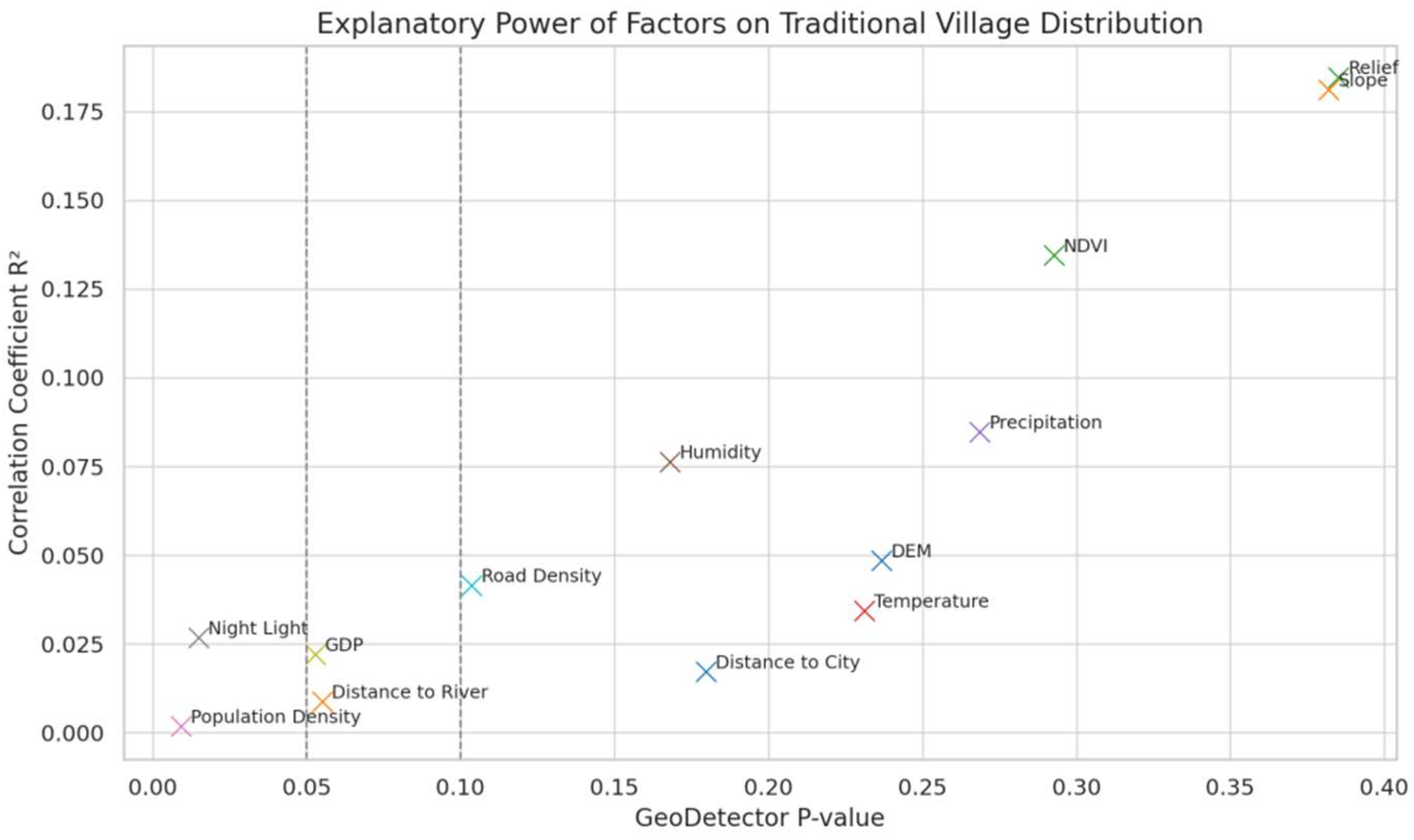
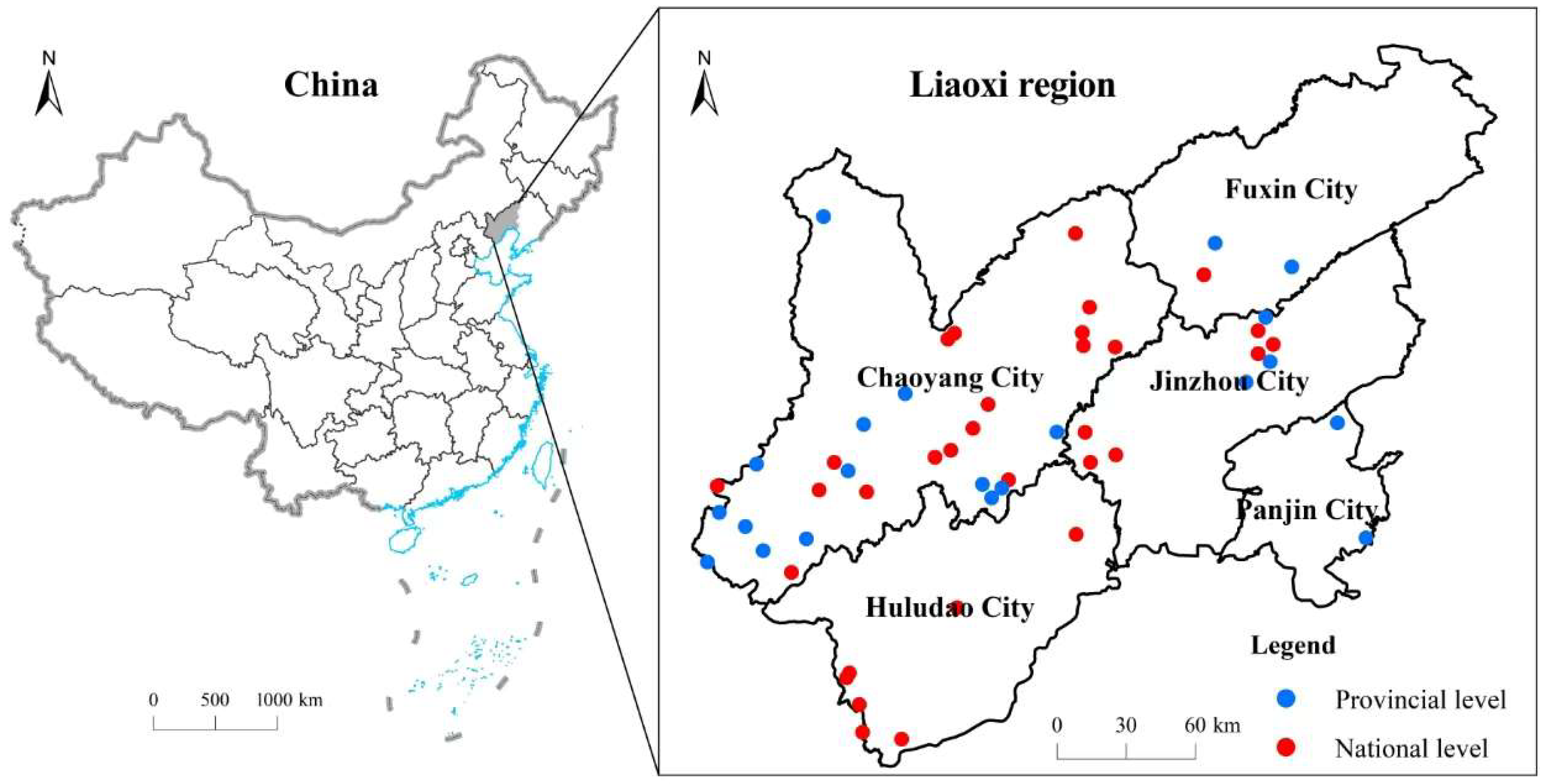
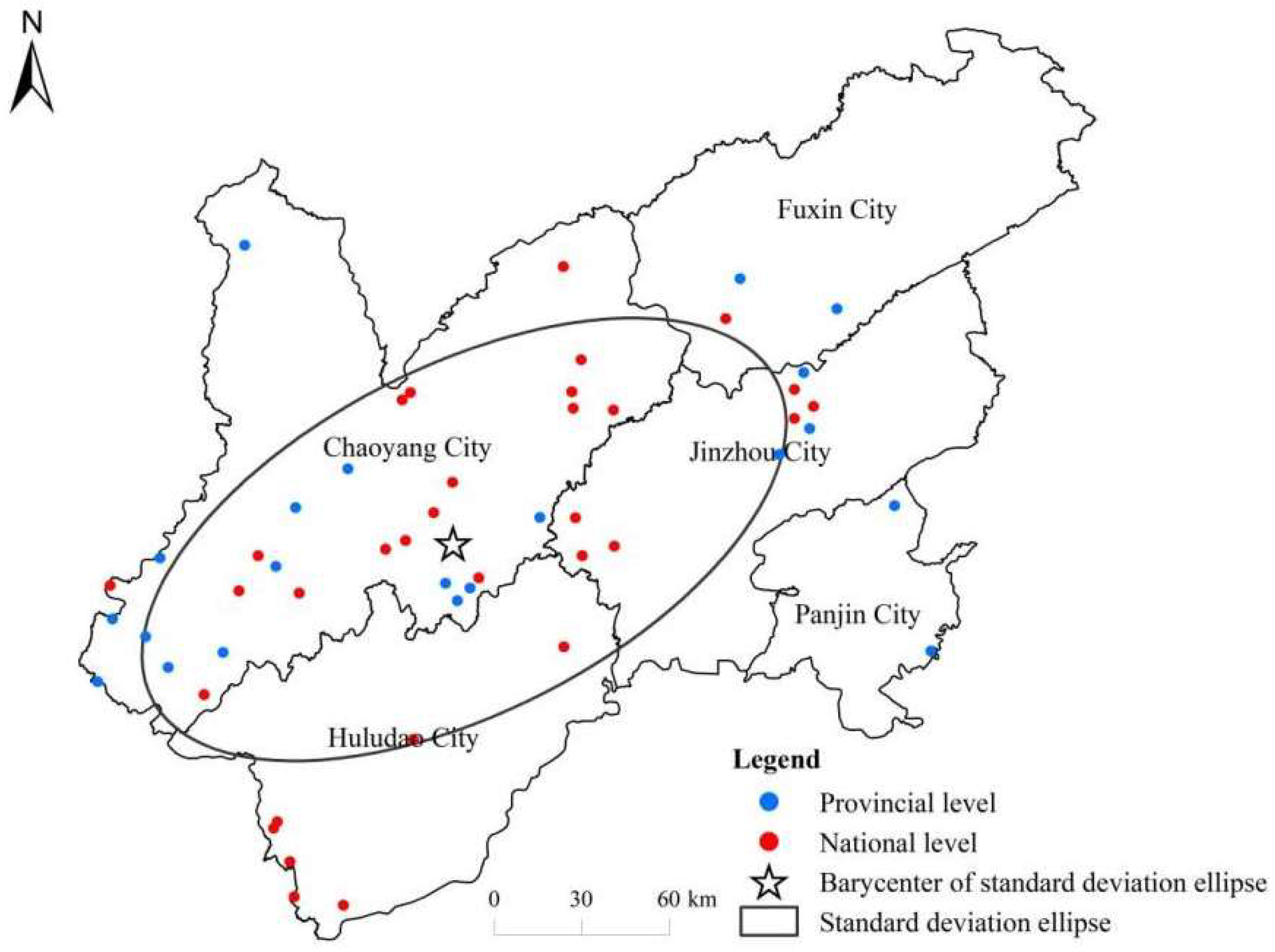
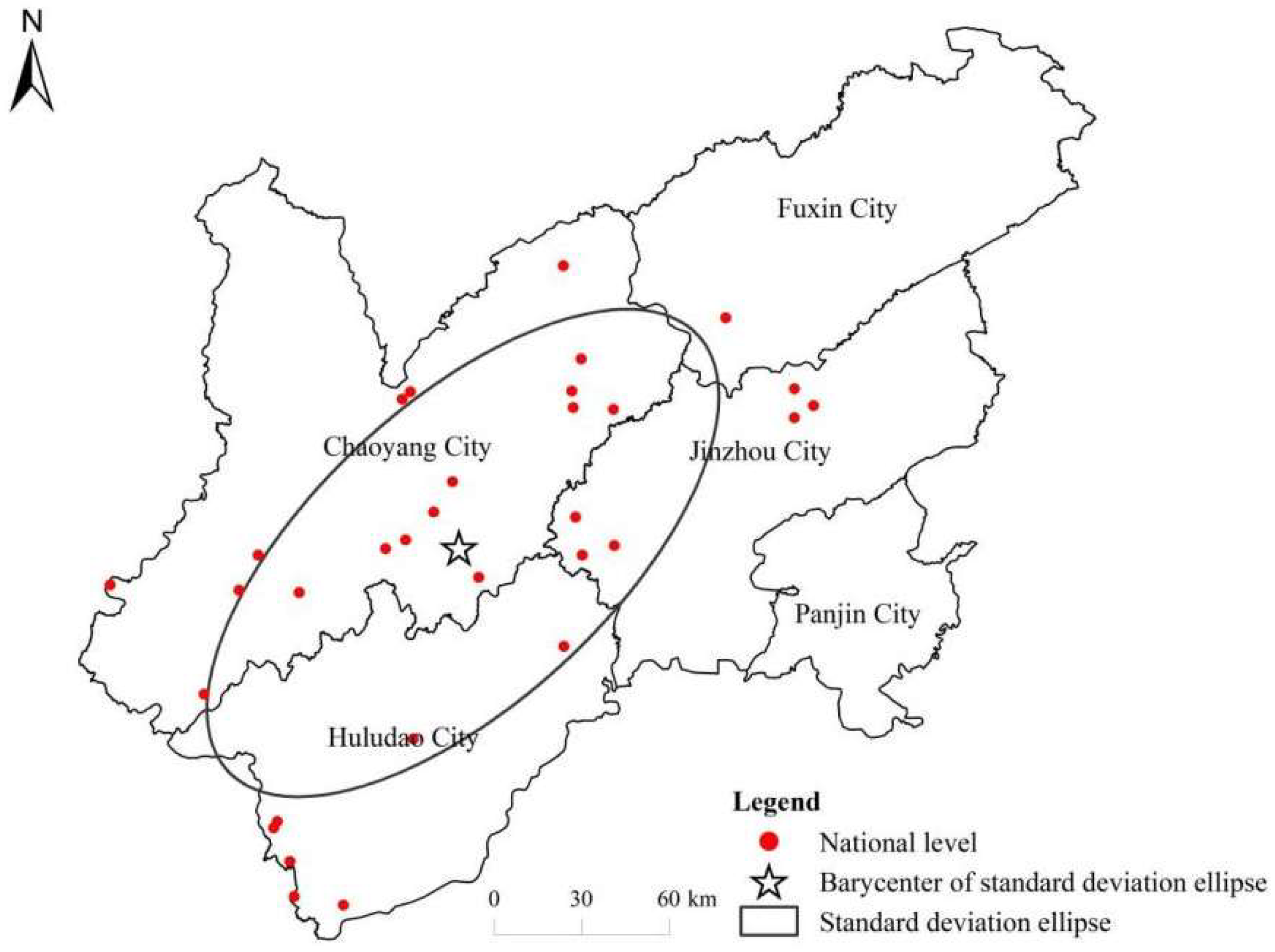
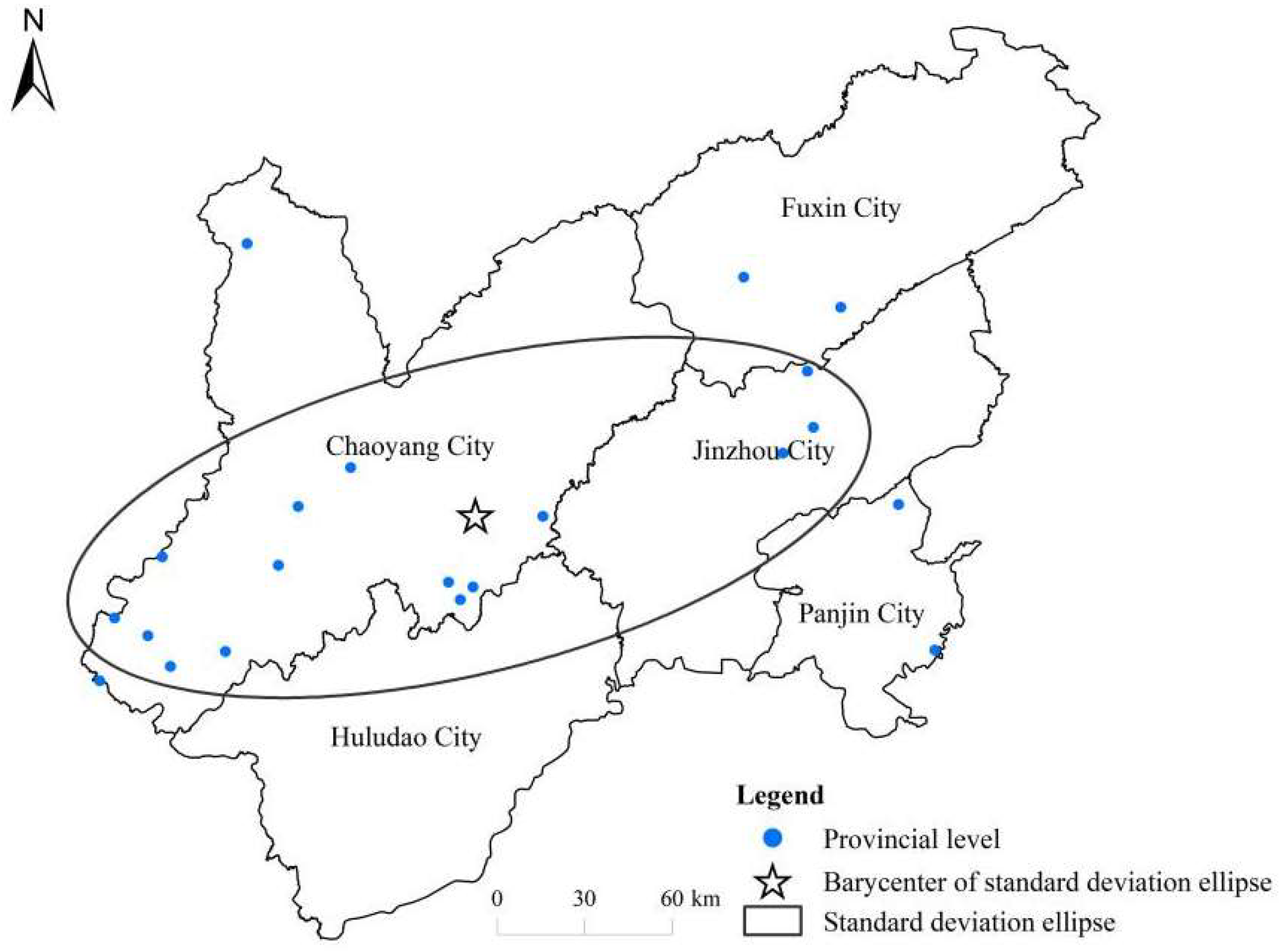
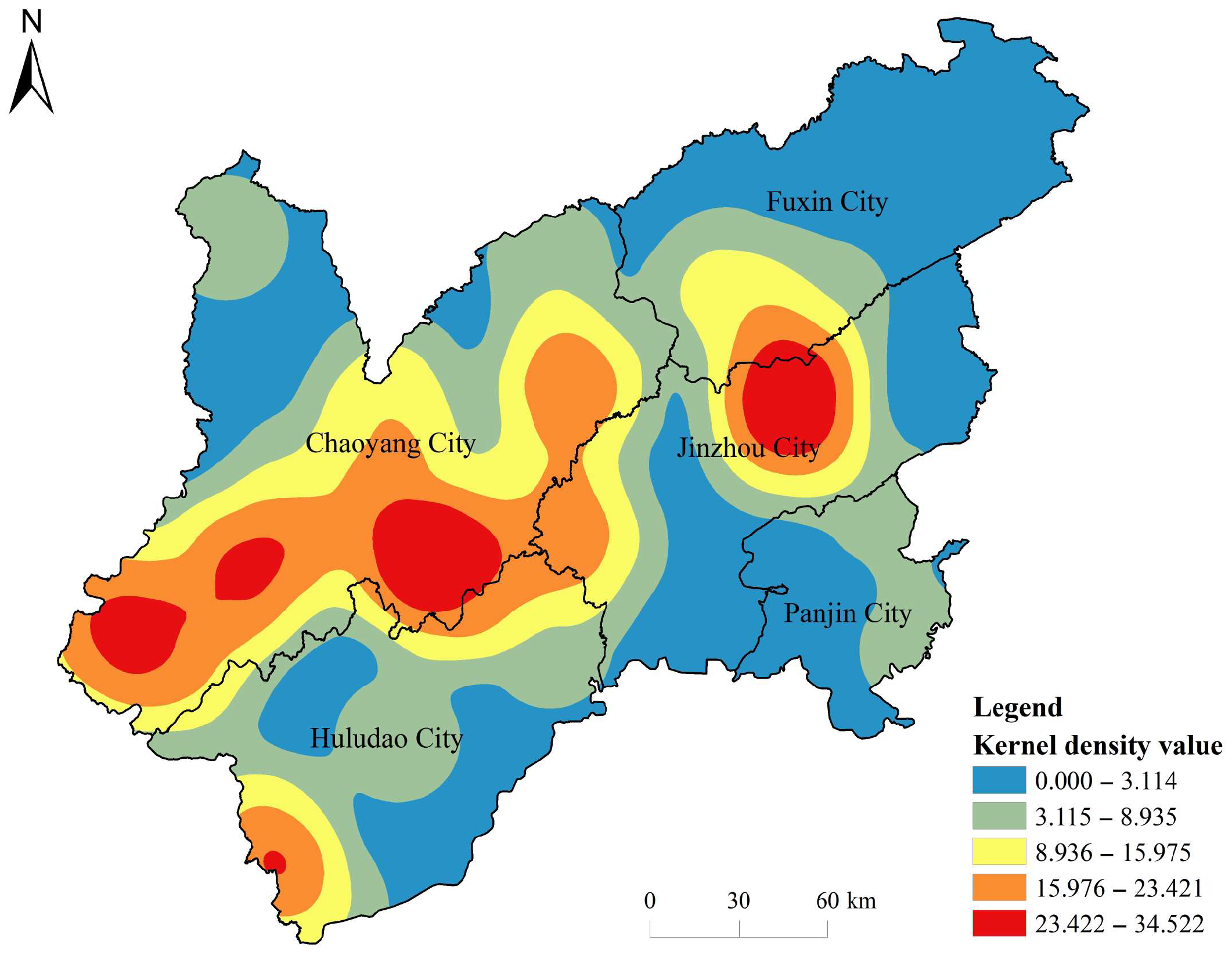
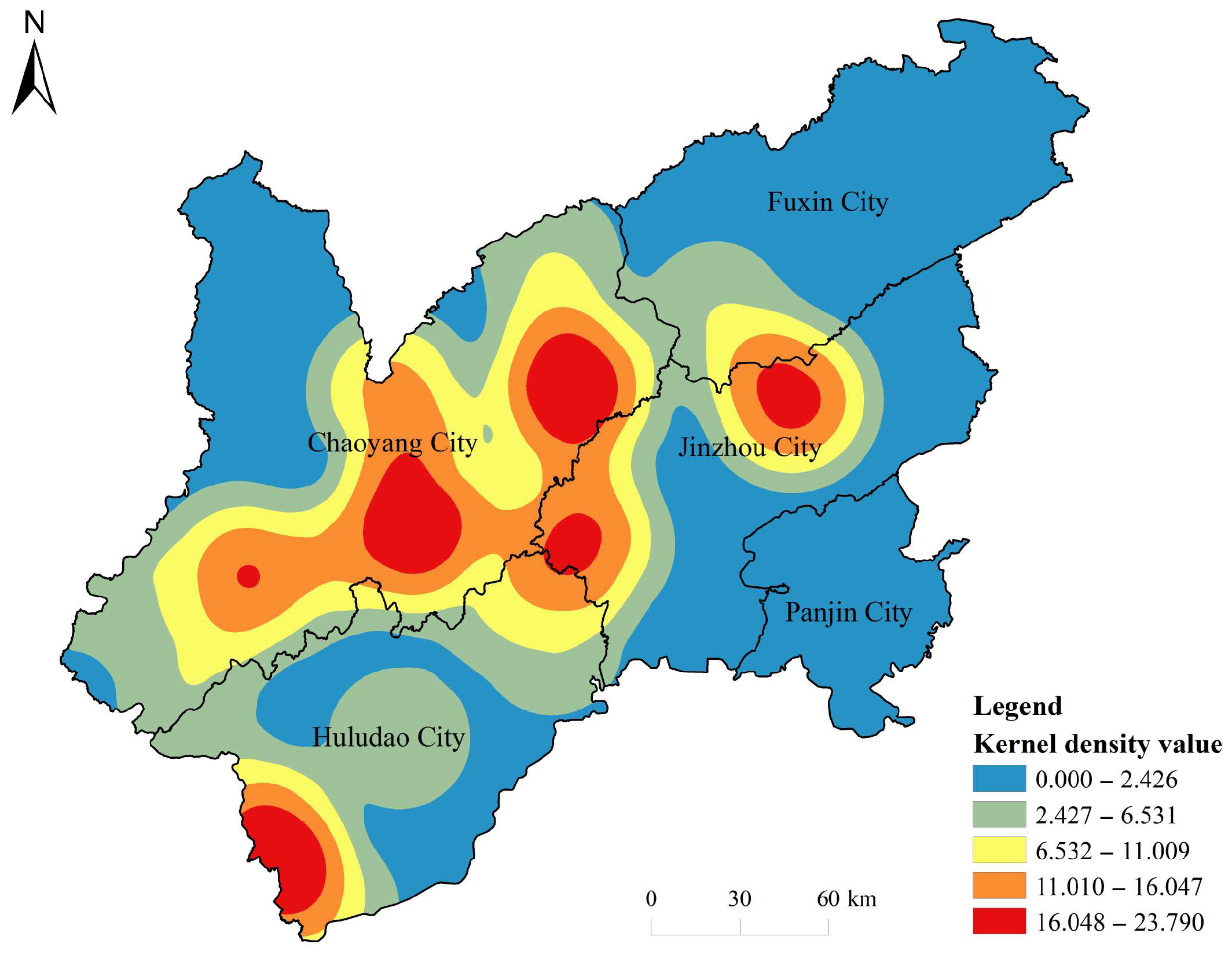
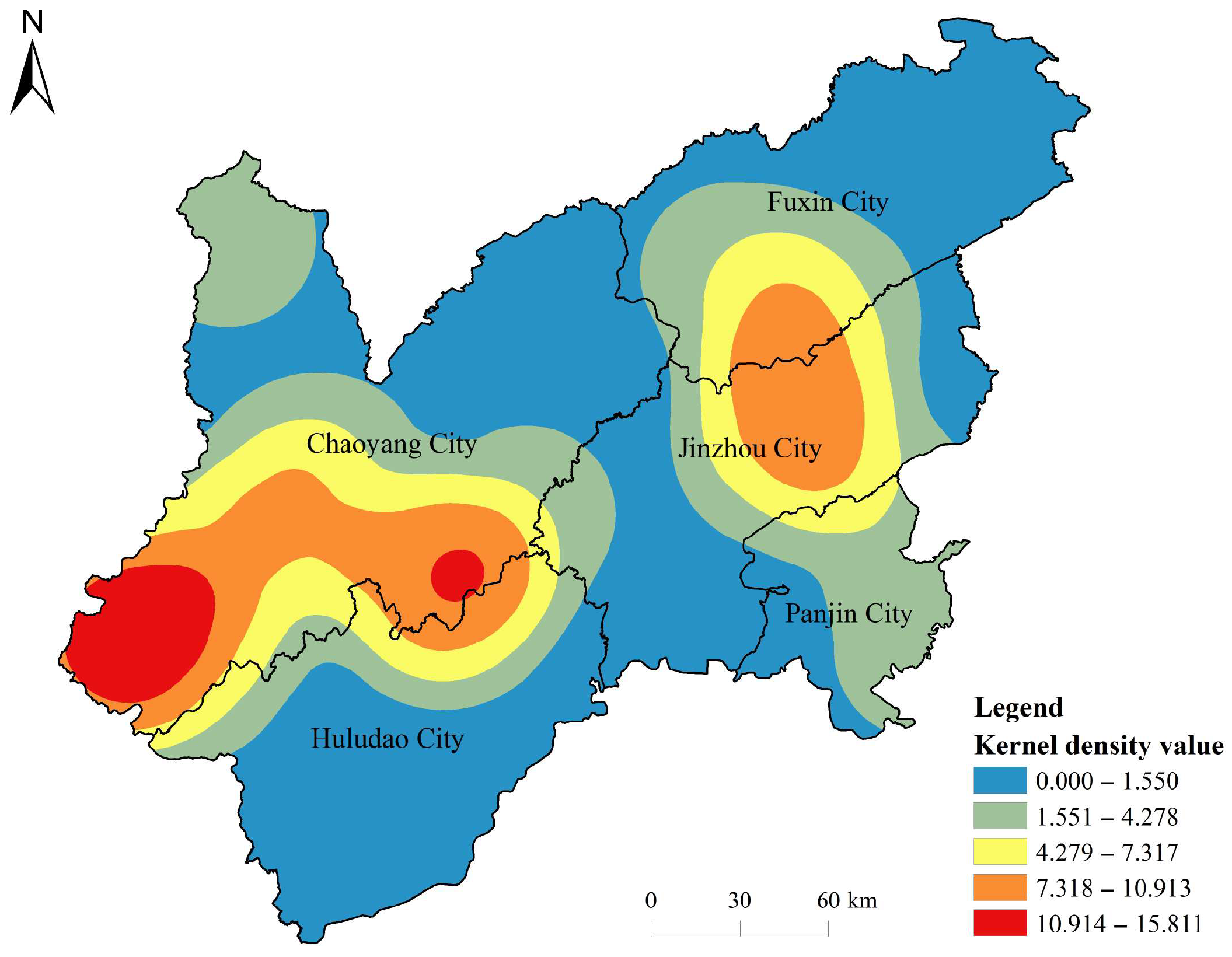

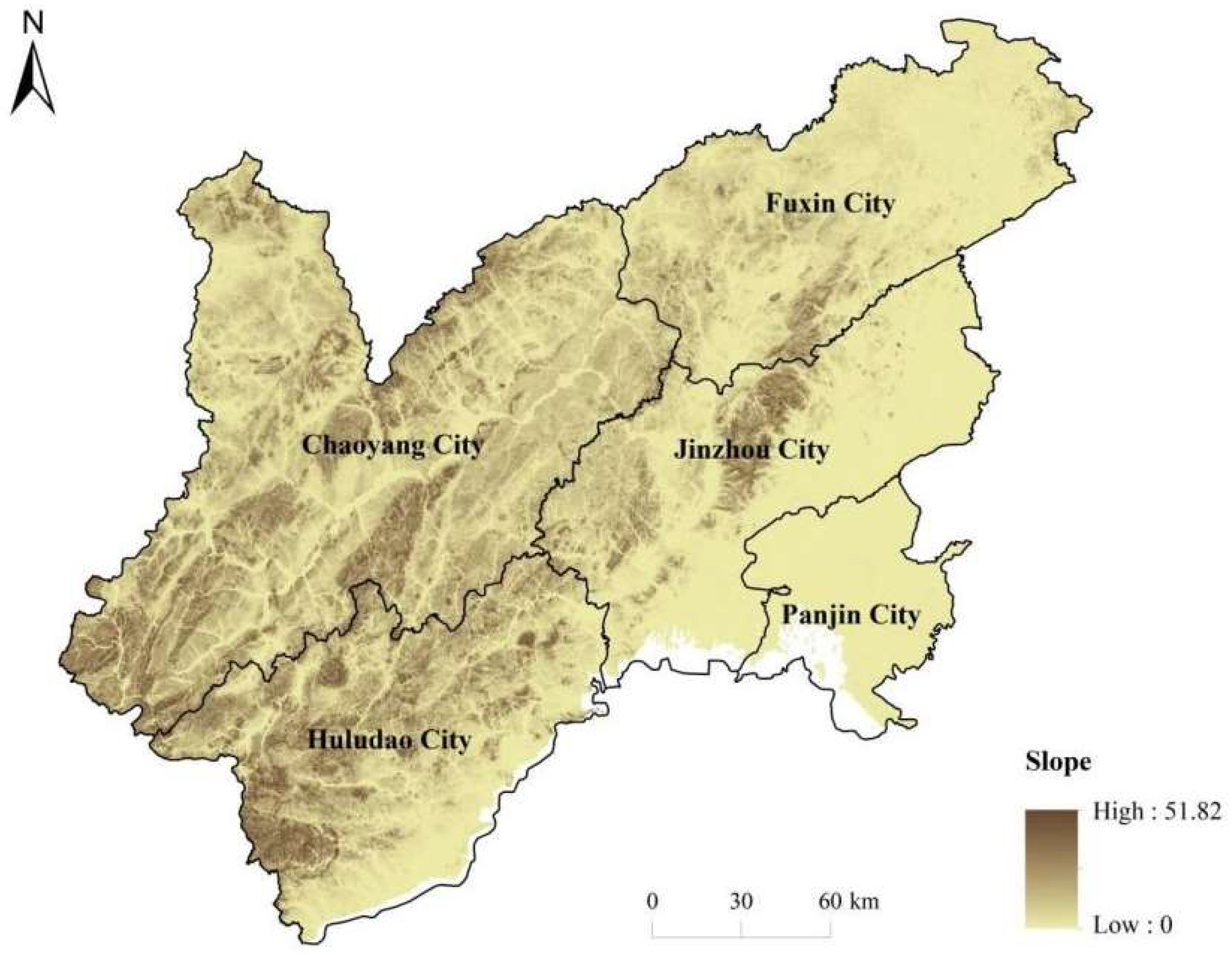
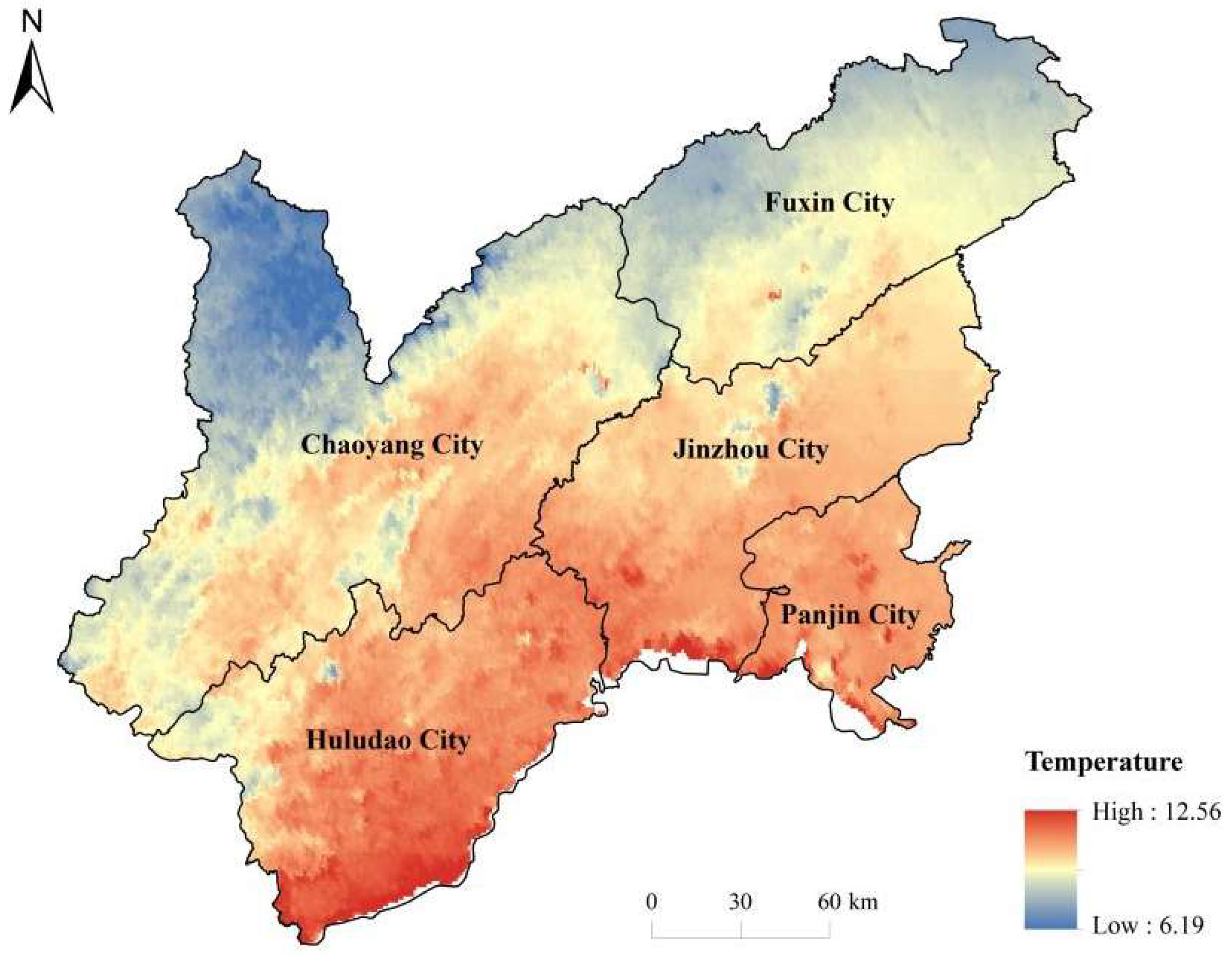

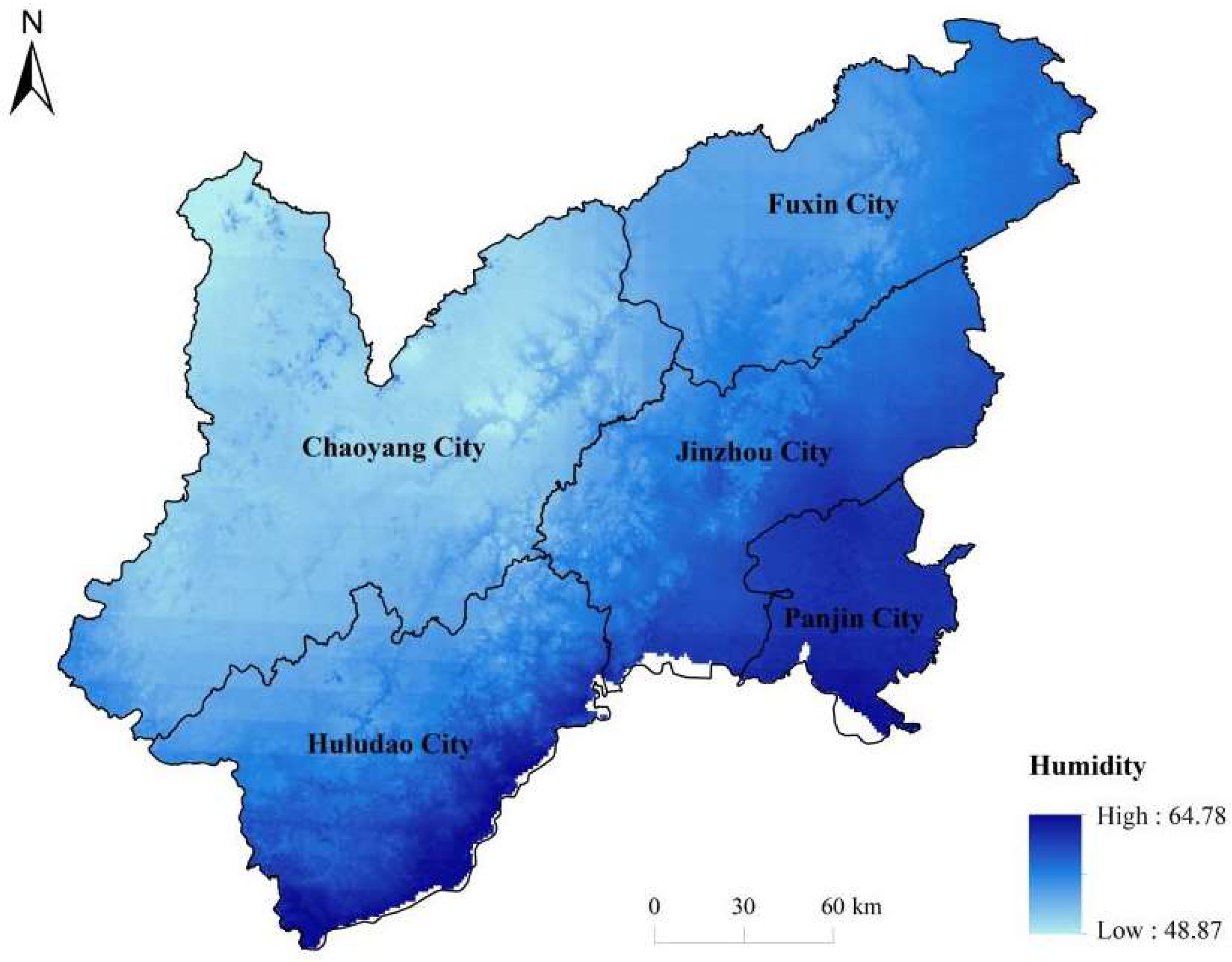
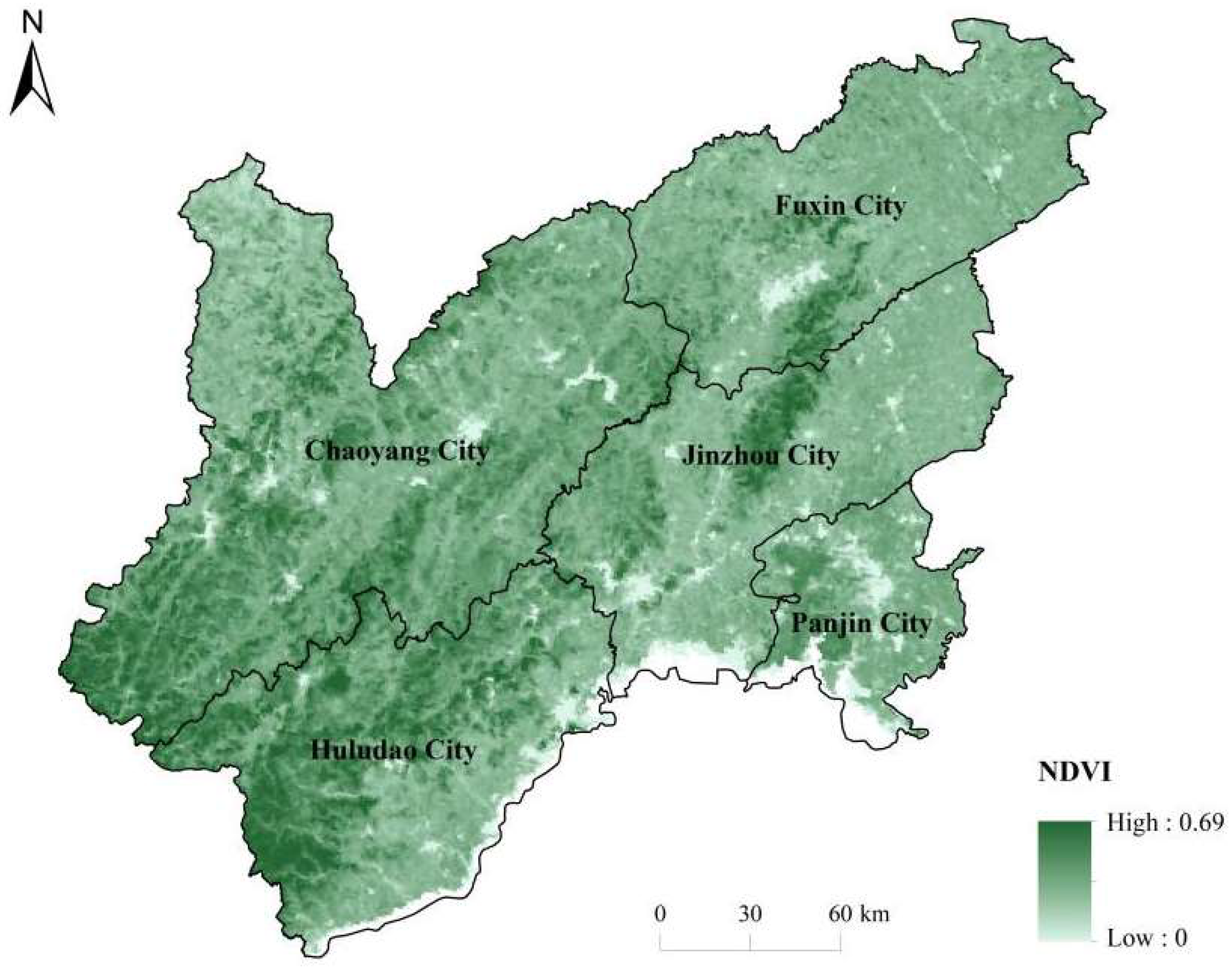

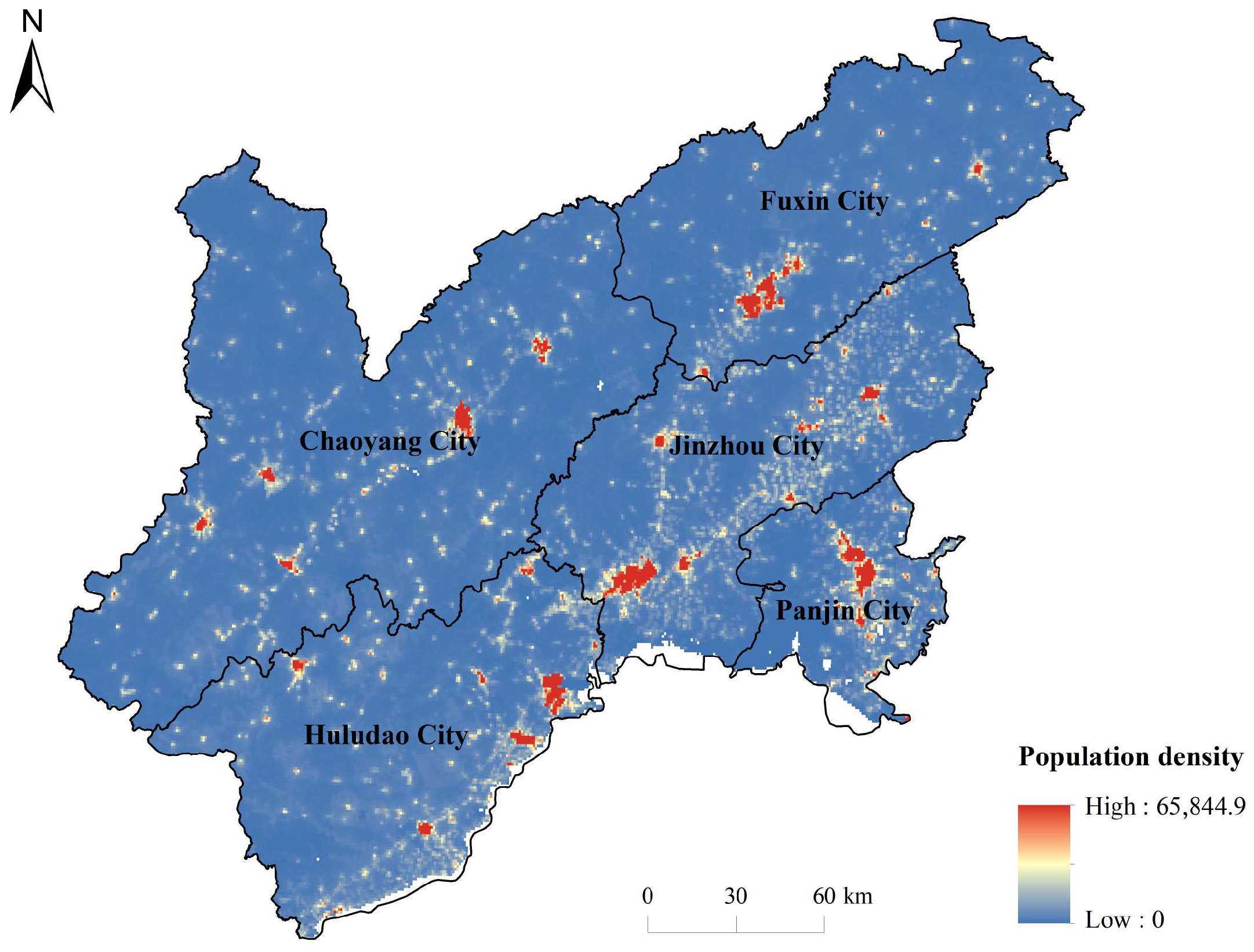
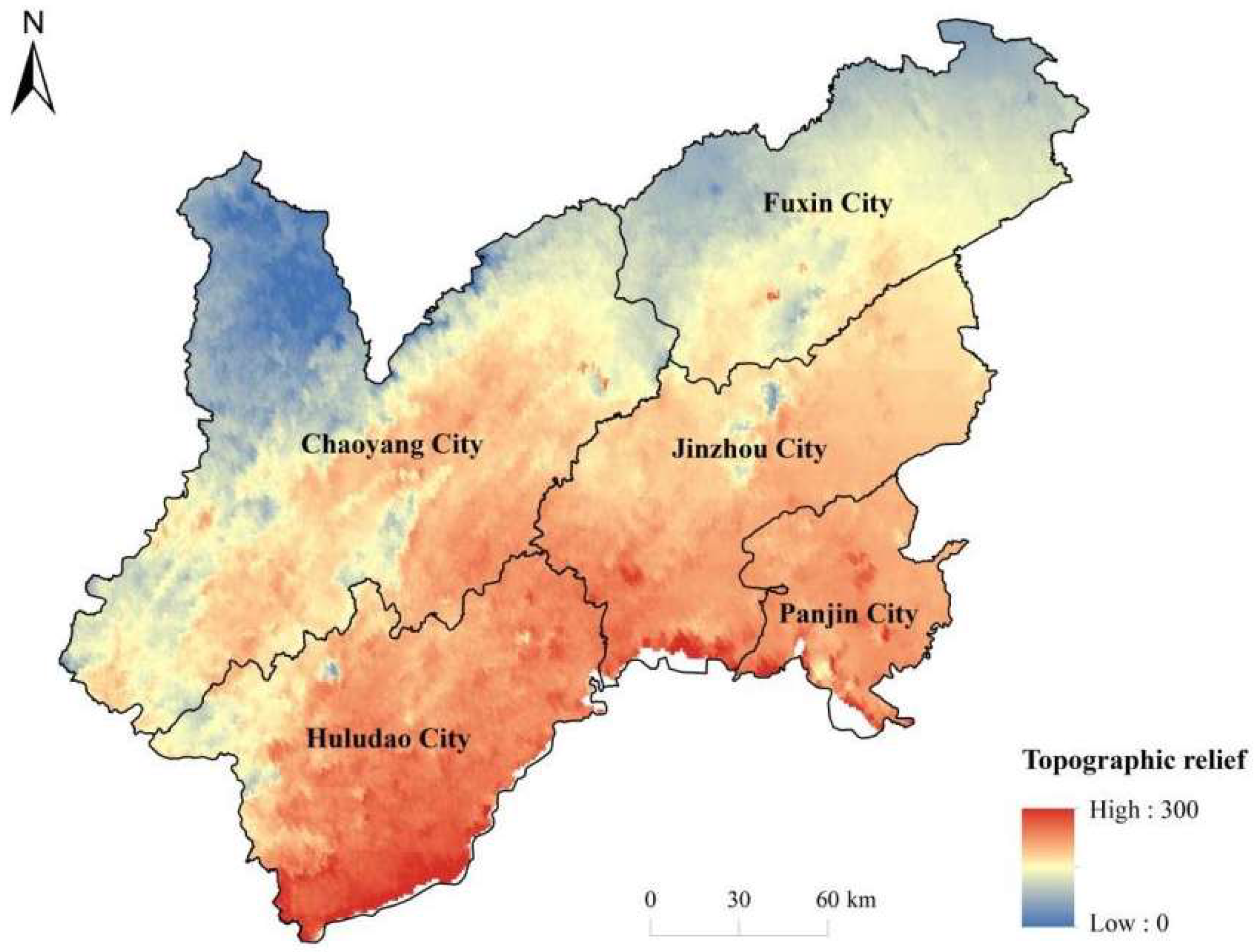
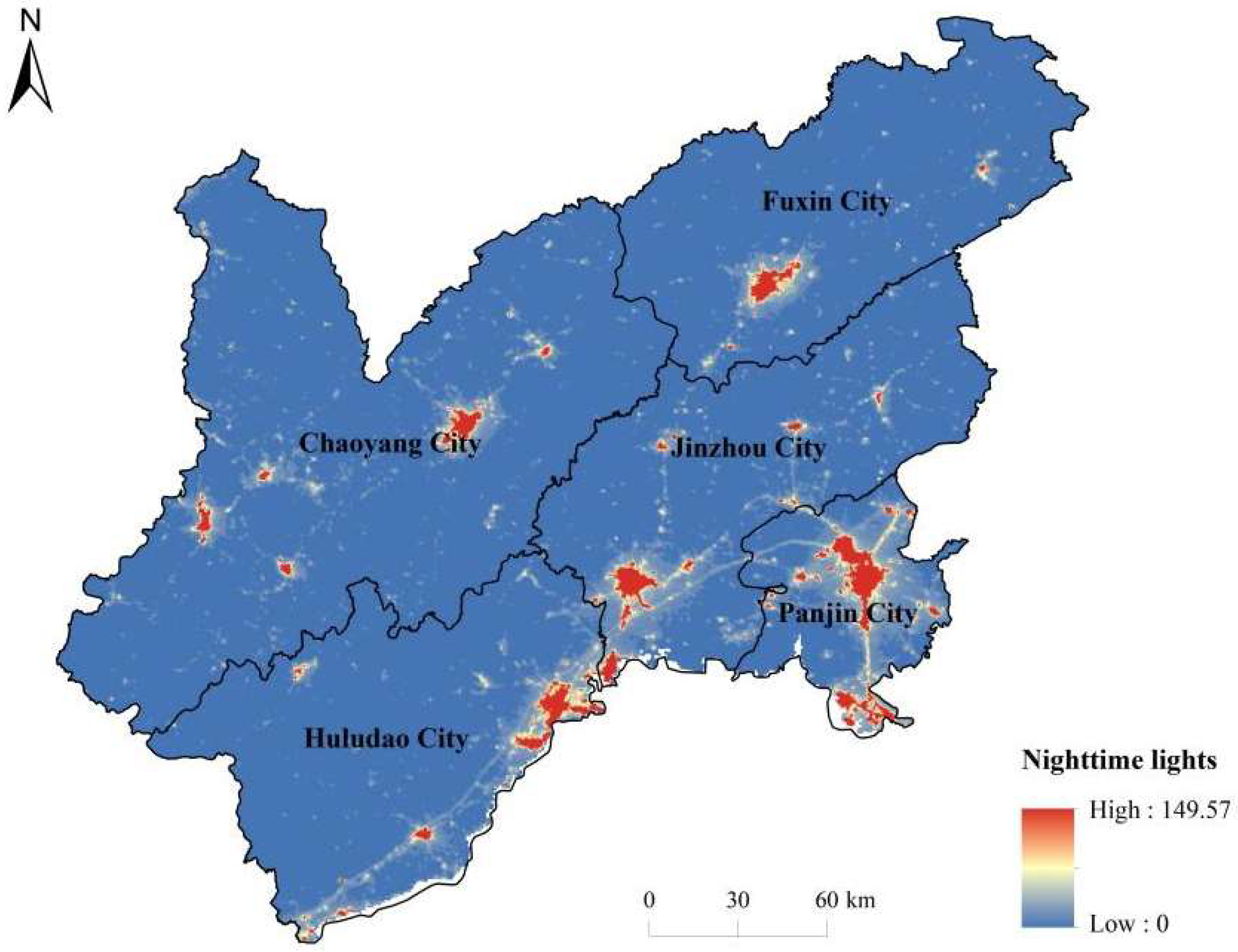
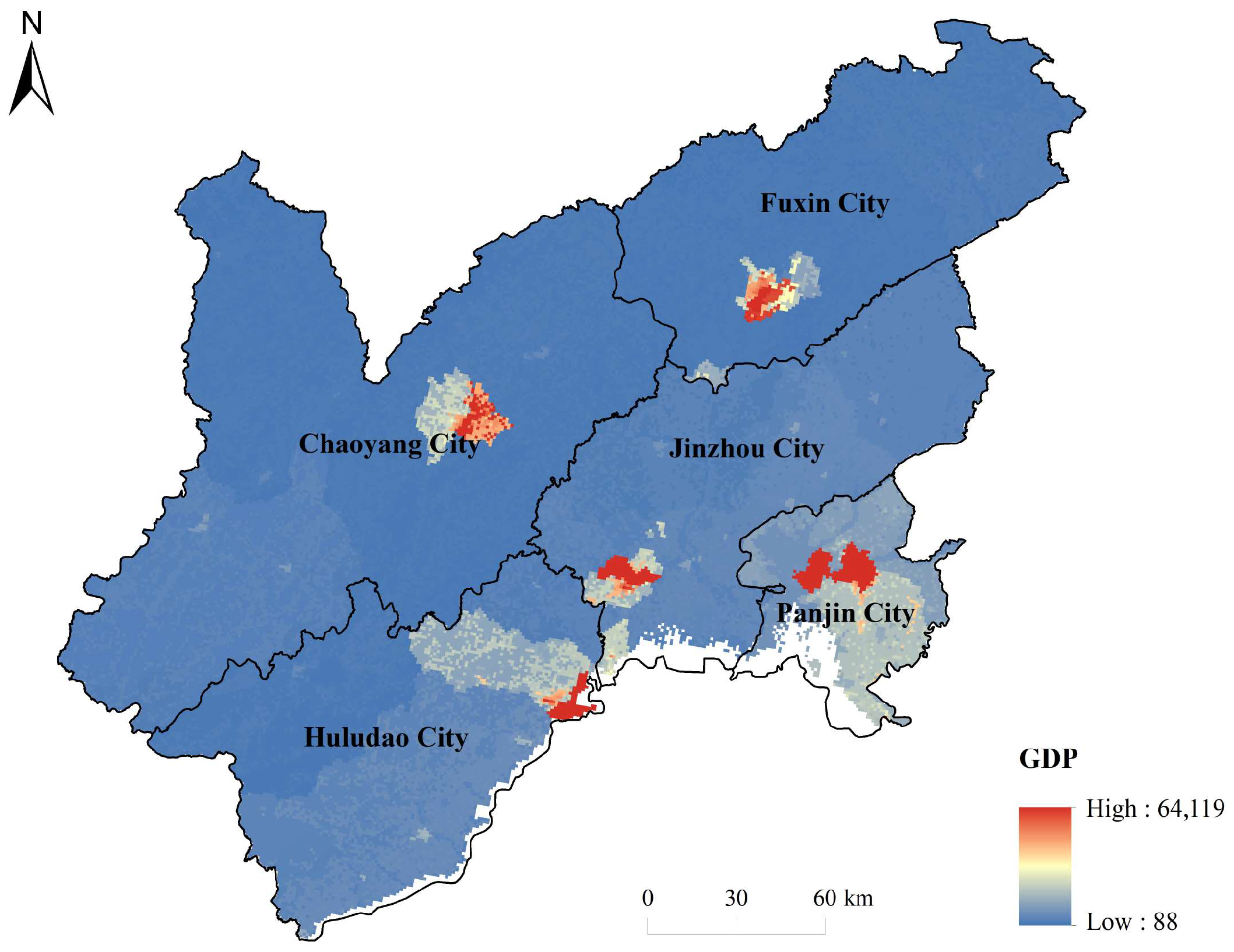

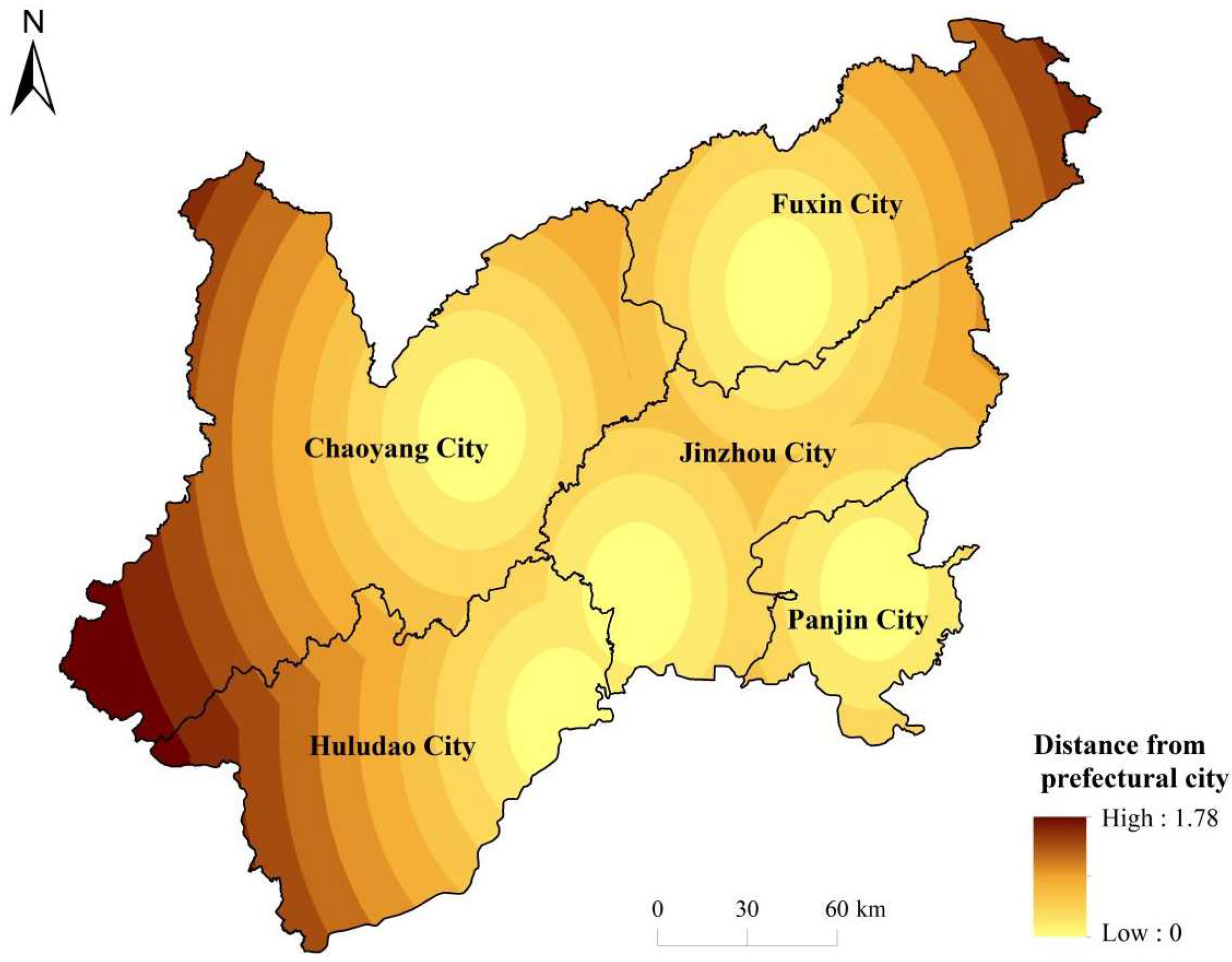
| Name | City | County/District | Town/Street | Level |
|---|---|---|---|---|
| Longgangzi Village | Jinzhou | Beizhen City | Futun Subdistrict | National |
| Xinbaozi Village | Huludao | Suizhong County | Lijiapu Township | National |
| Xiaojiadian Village | Chaoyang | Chaoyang County | Yangshan Town | National |
| Tangzhangzi Village Bapangou | Chaoyang | Chaoyang County | Beisijiazi Township | National |
| iansuo Village | Huludao | Suizhong County | Qiansuo Town | National |
| Shangkouzi Village | Panjin | Dawa County | Xi’an Town | Provincial |
| Desheng Village | Panjin | Panshan County | Desheng Town | Provincial |
| Gaoqibao Village | Jinzhou | Beizhen City | Baojia Township | Provincial |
| Sujiayingzi Village | Chaoyang | Chaoyang County | Qidaoling Town | Provincial |
| Zhangjiyingzi Village | Chaoyang | Chaoyang County | Heiniuyingzi Township | Provincial |
| Baiyin’aili Village | Chaoyang | Kalaqin Left Wing Mongol Autonomous County | Nanshao Subdistrict | National |
| Kangguan Village | Chaoyang | Lingyuan City | Songzhangzi Town | Provincial |
| Guozhangzi Village | Chaoyang | Lingyuan City | Liuzhangzi Township | Provincial |
| Shaoguodi Village | Chaoyang | Lingyuan City | Daoerdeng Town | Provincial |
| Laoxigou Village | Chaoyang | Jianping County | Heishui Town | Provincial |
| Dongguan Branch | Chaoyang | Kalaqin Left Wing Mongol Autonomous County | Guandahai Management Area | Provincial |
| Shuangta Village | Jinzhou | Beizhen City | Beizhen Subdistrict | Provincial |
| Dayi Village | Jinzhou | Beizhen City | Dashi Town | Provincial |
| Fosi Village | Fuxin | Fuxin Mongol Autonomous County | Fosi Town | National |
| Yamen Village | Fuxin | Fuxin Mongol Autonomous County | Daban Town | Provincial |
| Wangfu Village | Fuxin | Fuxin Mongol Autonomous County | Wangfu Town | Provincial |
| Bajiazi Village | Chaoyang | Chaoyang County | Wangyingzi Township | Provincial |
| Er’angou Village | Chaoyang | Lingyuan City | Goumenzi Town | National |
| Lieshanliang Village | Chaoyang | Lingyuan City | Sanshijiazi Town | National |
| Xidazhangzi Village | Chaoyang | Chaoyang County | Liucheng Town | National |
| Sandaogou Village | Chaoyang | Chaoyang County | Xiwujiazi Township | National |
| Fengzhangzi Village Baicaogou | Chaoyang | Chaoyang County | Shangzhi Township | Provincial |
| Xindi Village | Chaoyang | Chaoyang County | Xiwujiazi Township | National |
| Sanjuxing Village | Chaoyang | Beipiao City | Shangyuan Town | National |
| Botaigou Village | Chaoyang | Beipiao City | Daban Town | National |
| Pandaogou Village | Huludao | Lianshan District | Tashan Township | National |
| Wangjiadian Village | Huludao | Suizhong County | Jiabeiyan Township | National |
| Sanjia Village | Chaoyang | Chaoyang County | Shengli Town | National |
| Wujiazi Village | Chaoyang | Kalaqin Left Wing Mongol Autonomous County | Gongyingzi Town | Provincial |
| Sunjiadian Village | Chaoyang | Chaoyang County | Shengli Town | National |
| Nanwa Village | Chaoyang | Chaoyang County | Bolochi Town | Provincial |
| Sanfu Village | Chaoyang | Beipiao City | Xiafu Development Zone | National |
| Xigou Village | Huludao | Suizhong County | Yong’an Township | National |
| Shifo Village | Jinzhou | Beizhen City | Futun Subdistrict | National |
| Huashan Village | Jinzhou | Beizhen City | Dashi Town | National |
| Tianshenghao Village | Chaoyang | Lingyuan City | Sanjiazi Township | Provincial |
| Huzhangzi Village | Chaoyang | Lingyuan City | Sandaohazi Township | Provincial |
| Shimengou Village | Chaoyang | Lingyuan City | Qianjin Township | Provincial |
| Xiaowopu Village | Chaoyang | Lingyuan City | Siguanyingzi Town | National |
| Shierguanyingzi Village | Chaoyang | Lingyuan City | Wulanbai Town | National |
| Jinlingsi Village | Chaoyang | Beipiao City | Daban Town | National |
| Banjita Village | Jinzhou | inghai City | Banjita Town | National |
| Mangniutun Village | Jinzhou | inghai City | Cuiyan Town | National |
| Huangmuzhangzi Village | Huludao | Suizhong County | Jiabeiyan Township | National |
| Xitai Village | Huludao | Xingcheng City | Sandaogou Township | National |
| Danian Village | Jinzhou | inghai City | Shenjiatai Town | National |
| Miliying Village | Chaoyang | Beipiao City | Baoguolao Town | National |
| Class I | Class II | Indicators | Data Source |
|---|---|---|---|
| Natural Factors | Terrain Factors | Elevation | http://www.gscloud.cn |
| Slope | |||
| Surface relief | |||
| Climate Factors | Temperature | http://www.resdc.cn | |
| Precipitation | |||
| Humidity | |||
| Environmental Factors | Distance to water system | http://ngcc.sbsm.gov.cn/ | |
| NDVI | http://www.resdc.cn | ||
| Human Factors | Population and Economy | Population density | http://www.resdc.cn |
| Night lighting | |||
| GDP | |||
| Transportation Location | Road network density | http://ngcc.sbsm.gov.cn/ | |
| Distance to county center |
| Field Name | Chinese Name | Meaning Explanation |
|---|---|---|
| CenterX | Ellipse Center X Coordinates | The coordinates of the center of gravity (center) of an ellipse in the east–west direction, usually in longitude or projected coordinates X values. It reflects the “geographic mean center” of the spatial distribution of villages in this category. |
| CenterY | Ellipse Center Y Coordinate | The coordinate of the center of gravity of the ellipse in the north–south direction, usually the latitude or projected coordinate Y value. |
| XStdDist | The standard deviation of the X-axis | Indicates the degree of spatial dispersion of village points in the ** major axis direction (long axis direction) **. Larger values indicate a more “elongated” spatial distribution. The unit is usually meters. |
| YStdDist | Y-axis standard deviation | Indicates the degree of dispersion of village points in the ** sub-axis direction (short-axis direction) **. The smaller the value, the more concentrated the distribution is on the major axis. |
| Rotation | Angle of rotation | The angle (in degrees °) of the long axis of an ellipse relative to due north, usually counterclockwise. Reflects the directional trend of the overall distribution of villages. |
| Shape_Length | Perimeter of an ellipse | The length of the boundary line of an ellipse in meters, reflecting the “closeness” or “peripheral complexity” of the entire spatial extent. |
| Shape_Area | Area of the ellipse | The area of the standard deviation ellipse (in square meters) reflects the total amount of spatial extent “covered” by the distribution of villages in this category. The larger the value, the wider the distribution. |
| Village Type | Mean Observed Distance (km) | Expected Mean Distance (km) | Nearest-Neighbor Index R |
|---|---|---|---|
| Total | 15.136 | 17.374 | 0.871 |
| National level | 16.097 | 16.273 | 0.989 |
| Provincial level | 24.139 | 22.437 | 1.076 |
| Village Type | CenterX | CenterY | XStdDist | YStdDist | Rotation | Shape_Length | Shape_Area |
|---|---|---|---|---|---|---|---|
| Total | 120.3907 | 41.2349 | 120,229.0213 | 59,399.8127 | 63.03° | 580,597.3786 | 22,433,800,775 |
| National Level | 120.3873 | 41.1922 | 109,907.4401 | 51,136.0609 | 47.20° | 522,901.6645 | 17,654,634,966 |
| Provincial | 120.3957 | 41.2979 | 140,794.9502 | 53,305.5949 | 76.11° | 641,129.2285 | 23,574,656,648 |
Disclaimer/Publisher’s Note: The statements, opinions and data contained in all publications are solely those of the individual author(s) and contributor(s) and not of MDPI and/or the editor(s). MDPI and/or the editor(s) disclaim responsibility for any injury to people or property resulting from any ideas, methods, instructions or products referred to in the content. |
© 2025 by the authors. Licensee MDPI, Basel, Switzerland. This article is an open access article distributed under the terms and conditions of the Creative Commons Attribution (CC BY) license (https://creativecommons.org/licenses/by/4.0/).
Share and Cite
Cao, H.; Kim, E. Analysis of Influencing Factors on Spatial Distribution Characteristics of Traditional Villages in the Liaoxi Corridor. Land 2025, 14, 1572. https://doi.org/10.3390/land14081572
Cao H, Kim E. Analysis of Influencing Factors on Spatial Distribution Characteristics of Traditional Villages in the Liaoxi Corridor. Land. 2025; 14(8):1572. https://doi.org/10.3390/land14081572
Chicago/Turabian StyleCao, Han, and Eunyoung Kim. 2025. "Analysis of Influencing Factors on Spatial Distribution Characteristics of Traditional Villages in the Liaoxi Corridor" Land 14, no. 8: 1572. https://doi.org/10.3390/land14081572
APA StyleCao, H., & Kim, E. (2025). Analysis of Influencing Factors on Spatial Distribution Characteristics of Traditional Villages in the Liaoxi Corridor. Land, 14(8), 1572. https://doi.org/10.3390/land14081572







